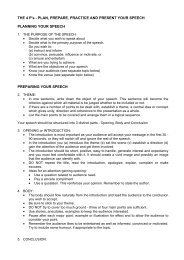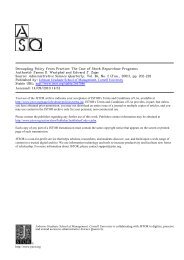Earnings Surprises, Growth Expectations, and Stock Returns:
Earnings Surprises, Growth Expectations, and Stock Returns:
Earnings Surprises, Growth Expectations, and Stock Returns:
You also want an ePaper? Increase the reach of your titles
YUMPU automatically turns print PDFs into web optimized ePapers that Google loves.
constructed by allocating all firm-quarter observations in our sample to decile portfolios<br />
on the basis of market capitalization at the beginning of the quarter. An equal-weighted<br />
portfolio return is computed for each size portfolio in each quarter. Raw buy-hold returns<br />
for individual securities are then adjusted by subtracting the return on the portfolio to<br />
which the security belongs based on its market capitalization at the beginning of the<br />
quarter. Our objective is to examine stock return behavior over the 20 quarters following<br />
the measurement of the growth/value characteristics <strong>and</strong> to relate the returns to the<br />
earnings surprises reported in each of these 20 quarters. To this end, we cumulate<br />
abnormal returns over four different intervals for each quarter. These intervals are<br />
illustrated in figure 3.<br />
The first abnormal return measurement interval begins two days after the<br />
announcement of earnings for the previous quarter <strong>and</strong> ends the day after the<br />
announcement of earnings for the current quarter. We obtain quarterly earnings<br />
announcement dates from COMPUSTAT. We refer to the quarterly return measured<br />
over this interval as ‘fullret’. This interval averages 63 trading days in length. We next<br />
divide this interval into two sub-intervals, the later of which is designed to capture<br />
earnings-related announcements. The first interval begins two days after the<br />
announcement of earnings for the prior quarter <strong>and</strong> ends thirteen trading days prior to the<br />
end of the current fiscal quarter. The second interval begins twelve trading days prior to<br />
the end of the current fiscal quarter <strong>and</strong> ends the day after the announcement of earnings<br />
for the current quarter. Evidence in Skinner (1997) <strong>and</strong> Soffer et al. (1999) indicates that<br />
over 75% of all earnings preannouncements occur within two weeks on either side of the<br />
fiscal quarter end. Hence, we expect all but a small portion of earning surprises to be<br />
12







